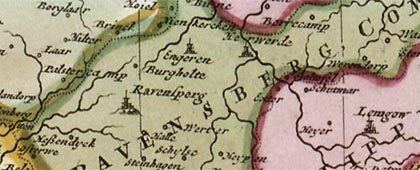Otto I, Count of Ravensberg 1140s 1140s Preceded by Succeeded by Date dissolved 1807 | Disestablished 1807 | |
 | ||
Weather 6°C, Wind W at 3 km/h, 82% Humidity | ||
The County of Ravensberg (German: Grafschaft Ravensberg) was a historical county of the Holy Roman Empire. Its territory was in present-day eastern Westphalia, Germany at the foot of the Osning or Teutoburg Forest.
Contents
History
Ravensberg was first mentioned in the 12th century; its first capital was Burg Ravensberg. The Counts of Ravensberg then had Sparrenberg Castle built in Bielefeld c. 1240–50, which they made their seat.
The county was later inherited by the Duchy of Berg in 1346, which in turn became part of the Duchy of Jülich-Berg in 1423, and ultimately the United Duchies of Jülich-Cleves-Berg in 1521.
After the War of the Jülich succession, in the Treaty of Xanten in 1614, the County of Ravensberg came to the Margraviate of Brandenburg, which became the Kingdom of Prussia in 1701, and was administered within Minden-Ravensberg from 1719–1807, when it was dissolved during the Napoleonic Wars.
Aside from Bielefeld, other communities in the County of Ravensberg were Borgholzhausen, Halle, Steinhagen, Versmold, Werther, Isselhorst (now part of Gütersloh), Enger, Hiddenhausen, Rödinghausen, Spenge, Herford (except for Falkendiek), Bünde (except for Dünne and Spradow), Vlotho (except for Uffeln), Kirchlengern south of the Werre, Preußisch Oldendorf (except for Hedem and Lashorst) and Bad Oeynhausen south of the Werre.
House Calvelage-Ravensberg
House of Jülich
1348-1395 in Personal union with Berg, since 1437 with Jülich-Berg
House of La Marck, Dukes
– from 1521 a part of the United Duchies of Jülich-Cleves-Berg –
House of Hohenzollern
- from 1614 Margraves of Brandenburg and Kings of Prussia -
To France by the 1807 Treaty of Tilsit, incorporated into the Kingdom of Westphalia
